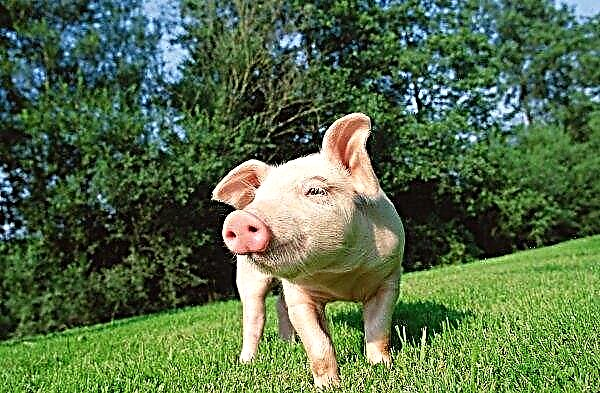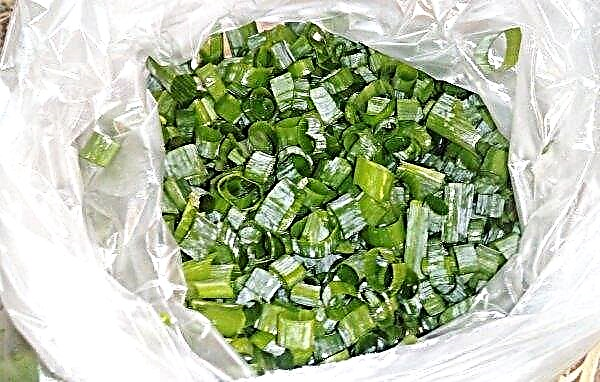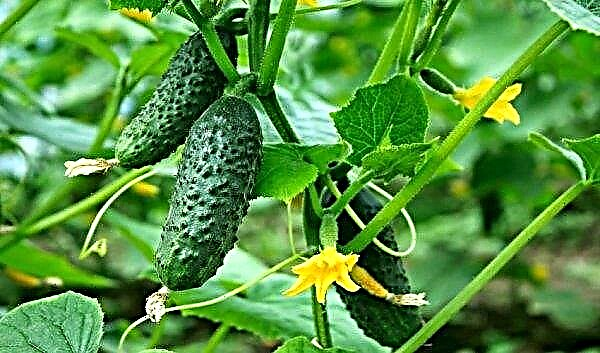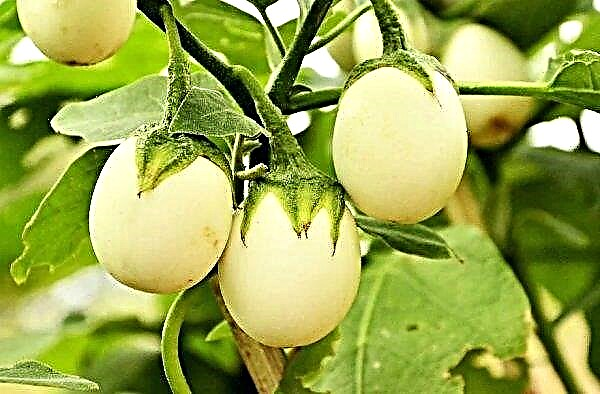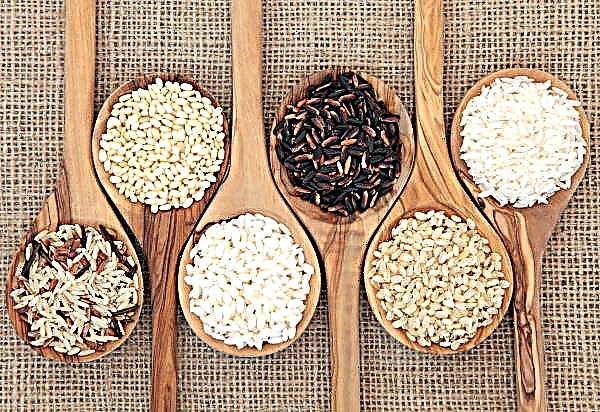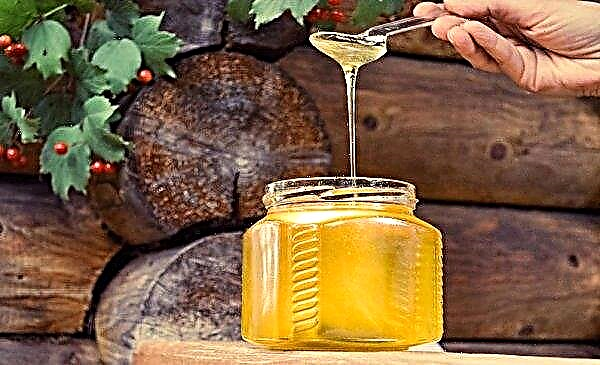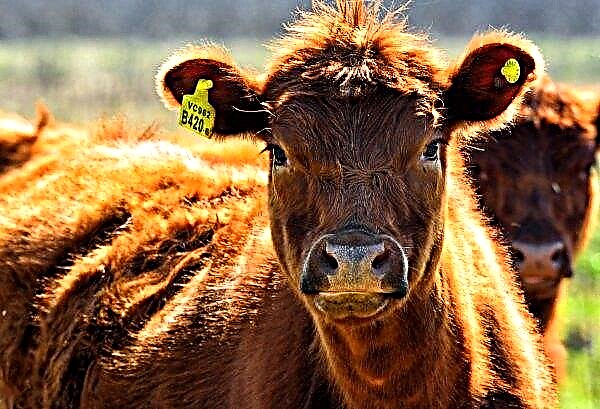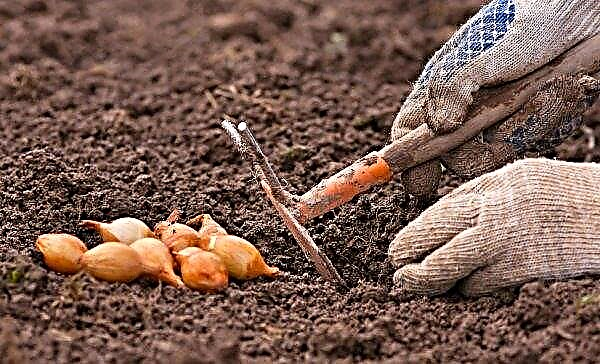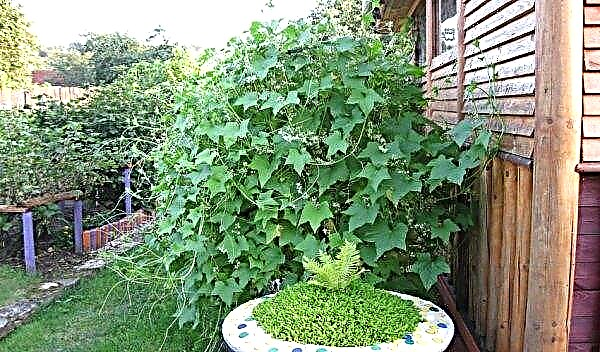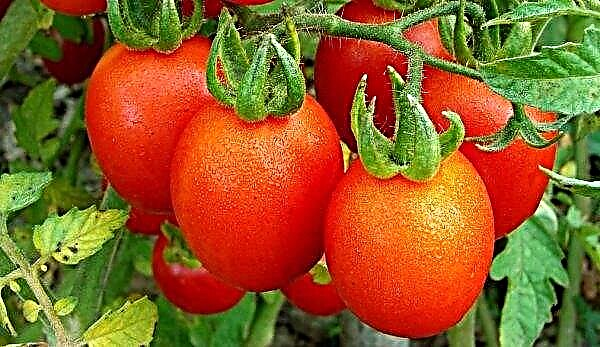This plant (but not its name) is easily recognizable, since it is widely used for decorative purposes everywhere. External showiness and unpretentiousness during cultivation made Dieffenbachia one of the most common indoor plants. The methods of its reproduction at home and the rules for caring for it will be described later.
Plant characteristics
In his homeland, in South America, Dieffenbach, so named in honor of the Austrian botanist J. Diffenbach, reaches a two-meter height. At home, it is not so high, but it is also effectively decorated with beautiful dark green large leaves with white and beige stains.
They are attached to a powerful stem, similar to a tree trunk, which under optimal conditions grows quite quickly.
Did you know? In slave times in the United States, delinquent slaves were often punished. toxic juice Dieffenbachia, which delivered punishable serious torment.
A characteristic feature of this houseplant is the presence of poisonous juice in it, which is released when the leaves or the stem are damaged and can cause severe burns to the mucous membranes and skin of humans and animals.
When you can propagate dieffenbachia
Like the vast majority of domestic flowers, Dieffenbachia is preferable to propagate in the spring. However, this period is not mandatory, since the unpretentiousness of this plant allows you to propagate it almost year-round.
For the breeding process, there are two ways:
- vegetative;
- generative.
The first, for which plant fragments taken from different parts of it are suitable, is used by amateur gardeners most often and does not create special problems even for the most inexperienced.
Generative propagation by means of dusted seeds is used extremely rarely, since Dieffenbachia almost does not bloom at home, and therefore does not produce seeds. Plants grown in this way are very rare and expensive.
Preparation for breeding
For growing Dieffenbachia, clay pots of the appropriate size for the development of the root system of a plant are best suited. Selected “for growth” are not suitable, it is fraught with rotting of the roots. As the flower grows, it is better to transplant it once again into a more voluminous container.
Important! Experts consider modern plastic pots uncomfortable for Dieffenbachia, since the absence of pores in the plastic makes air exchange in the root system more difficult, and soil moisture not regulated.
At the bottom of the flower pot, a drainage layer in the form of crushed brick and charcoal should be laid. A special role in the process of plant propagation is played by correctly selected soil.
The best substrate is peat in a mixture with vermiculite (perlite), combined in equal proportions. High-quality soil is also obtained from sphagnum, peat soil and perlite (vermiculite), where half the volume falls on sphagnum, and the rest is presented in equal proportions. In order to prevent root rot decay, the prepared soil is recommended to be enriched with activated carbon (in the ratio of 1 tablet per 0.5 l of substrate).
In order to prevent root rot decay, the prepared soil is recommended to be enriched with activated carbon (in the ratio of 1 tablet per 0.5 l of substrate).
Home breeding technology
To understand how dieffenbachia propagates, you need to know that the vegetative method involves the use of:
- cuttings;
- leaves;
- tops;
- stems;
- shoots;
- roots.
Cuttings
As cuttings, young parts of the stem of a light green color 10 cm long are used. They are rooted either in water or in a substrate. When using water to root, part of the cuttings are placed in it.
Water is disinfected with activated carbon, and to stimulate the rooting process it is useful to enrich the liquid with a few drops of aloe juice. To avoid decay of the cuttings, the water should be replaced with fresh water every week.
After about half a month, the first roots will appear on the handle. When they reach a length of 2 cm, the cuttings are planted in the ground, deepening them by 2-3 cm. To successfully root the cuttings immediately in the soil, you should:
To successfully root the cuttings immediately in the soil, you should:
- Prepare a quality stalk.
- Dry it within 24 hours.
- For 7–9 hours immerse it in a stimulating solution (for example, in Kornevin).
- Plant the cuttings in the soil to a depth of 5 cm.
- If the surrounding air is cool, cover the container with the handle with a transparent film to form a greenhouse effect.
Leaf
This method of plant propagation involves the following actions:
- Choose a high-quality leaf with an intact surface and bright color on the plant.
- Cut it and dry it for a day.
- Put in a container of water.
- When root processes are formed (2 cm long), the leaf is planted in the prepared soil.

Top
It is also a cuttings, but cut from the top of the bush just below the last kidney. This method of propagation dieffenbachia allows you to quickly get an adult plant with all its decorative advantages. However, the former plant can no longer be saved.
Therefore, this method is used mainly in cases where the plant has lost its lower leaves with age, or root rot has been found in it. Sometimes in this way you can save a bush affected by diseases.
To multiply the top gave a good result, you need:
- Carefully cut the top of the bush below the upper kidney.
- Immerse the lower fragment of the top in a container of water enriched with activated carbon.
- At an ambient temperature below +22 ° C, heat the water.
- Replace old water with fresh water weekly.
- When the roots are 3 cm long, plant the sprouted apex in the prepared soil.
Stalk
This method is predominantly anti-aging in nature and is used when the leaves begin to fall off, exposing the lower part of the trunk, and the leaves on the middle “floor” of the plant turn yellow. To root the stem, you need to find a growth point, from where the leaves begin to diverge. The stem is cut below this place by 7 cm.
Did you know? Designers argue that the coloring of leaves of different varieties of Diefenbachia is so diverse and original that these plants are suitable for decorating any premises decorated in a variety of styles.
Then you need to:
- Dry the cut stem (about a day).
- Dip it in the prepared soil.
- Create greenhouse conditions with a transparent film.
- Expect the germination of the stem (it does not germinate immediately, sometimes you have to wait six months).

Shoots
This method of reproduction is advantageous in that the entire plant is rejuvenated in parallel. Side young shoots that interfere with its development are removed and simultaneously used to propagate the flower.
To do this, you need:
- Cut off the shoot with a pair of young leaves.
- Put it in a container of water, pre-enriched with activated carbon.
- Changing water weekly, wait for root shoots to germinate (they should be 2-3 cm long).
- To plant a seedling in the prepared soil, bearing in mind that the sprouted shoot is already a practically full-fledged plant.
Root division
Since Dieffenbachia feels equally uncomfortable both in an overly spacious tank and in a tight one, its next transplant can be combined with reproduction by means of root division.
To this end:
- Release the bush with an earthen lump from the tank.
- Roots are washed in running water, while unwinding them.
- If root shoots damaged by rot are found, they are cut off, and the rest is treated with a low-concentrated solution of manganese or water with activated charcoal.
- Leave the root lump divided into several parts for a day to dry.
- Plant the shoots in the prepared soil.

Aftercare for the flower
For all its unpretentiousness and undemanding nature, Dieffenbach feels the need for competent care, which will create comfortable conditions for her and prolong her life.
It is most important to keep optimal for her:
- temperature within +18 ...– + 25 ° С (with the most comfortable indicator at +20 ° С);
- the moisture that this plant loves and which should be provided by daily spraying the bush with standing water and rubbing the leaves with a damp sponge;
- lighting (it should be bright, but without direct sunlight);
- soil consisting of peat, sheet land, sphagnum, crushed charcoal and river sand;
- irrigation with settled water (more frequent during active growth and moderate in winter);
- top dressing, especially relevant for active growth (every 10 days in the form of complex fertilizers for variegated decorative foliage plants and organics saturated with nitrogen).
Pest and Disease Control
Dieffenbachia belongs to those plants that clearly and clearly signal to the owner about the problems that have arisen.
Most often this is expressed in:
- drying of leafy endings, which may indicate insufficient humidity, increased soil acidity or the presence of drafts;
- swiftness in the fall of the lower tier of leaves caused by a lack of moisture in the soil or cramped pot;
- pallor of the green color, provoked by excessively bright lighting or excessive phosphorus in the soil;
- deformation and grinding of leaves, which indicates an excessive alkali content in the ground;
- rotting of the roots caused by excessive watering;
- thinning of the stem, indicating the old age of the bush.
Fungicidal drugs (for example, Fitosporin-M) will help get rid of many serious problems. In addition to violations of agricultural practices, the plant may suffer from an invasion of pests in the form of:
In addition to violations of agricultural practices, the plant may suffer from an invasion of pests in the form of:
- a mealybug, which forms flakes in the form of flour on the bush and soil, and which is most effectively combated with the help of Mospilan or Aktara preparations;
- thrips, due to which dark drying spots appear on the leaves, and which are controlled by insecticides by repeatedly spraying the bush every 2 days (covering the plant with a plastic bag helps);
- spider mite, giving out its presence by drying leaves and poorly distinguishable cobwebs on their reverse side (the tick is destroyed by insecticides by spraying and covering the bush with a transparent bag for several days with repeating the procedure every week);
- aphids that cause yellowing of the leaves (fight with the help of garlic infusion, a solution of laundry soap and even beer).
Important! Constantly low ambient temperatures can cause brown spots on the leaves.
Growing and Care Recommendations
In order for the cultivation of Dieffenbachia and its care to proceed successfully, it is necessary, in addition to observing the agrotechnical rules, to remember that:
- this plant has toxic juice, therefore it should be treated with rubber gloves, and the points of damage to the stem or leaves should be immediately wet with a rag, removing the protruding juice;
- when pruning any parts of the bush for subsequent propagation, it is necessary to disinfect cutting tools with alcohol, and sprinkle with chopped charcoal the cut points;
- the water tank in which it is placed for germinating the roots of the stalk must be in a warm place, but in no case under the influence of sunlight;
- it is not recommended to fill the jar with several cuttings, as this can provoke the process of their decay;
- when dividing the root system for subsequent reproduction, damage to the root processes should be avoided;
- When planting seedlings, do not use excessively spacious or too tight containers.
 Cultivated for a century and a half, Dieffenbachia has not only not exhausted its decorative resource, but also conquers new areas for itself in the premises where a person lives, works or has a rest.
Cultivated for a century and a half, Dieffenbachia has not only not exhausted its decorative resource, but also conquers new areas for itself in the premises where a person lives, works or has a rest.


